Dachshunds are one of the most adorable dog breeds on the planet, and they deserve all the care in the world.
Many people admit that one of the main reasons they don’t have a dog in the house is because they don’t have so much time at their hands, and one thing every dog owner has apart from love in their hearts is COMMITMENT.
A dachshund, just like every other dog, requires ADEQUATE and OPTIMUM CARE. In this article we will give you all the advise you need about dachshund care.
What care do dachshunds need?
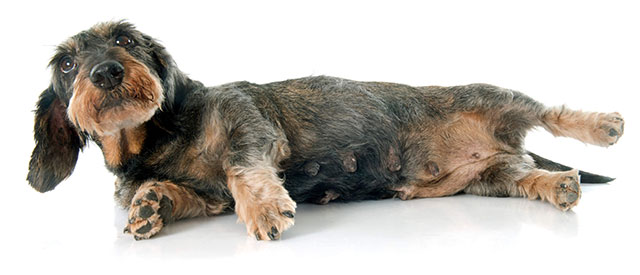
A sausage dog is a very independent dog that needs to be watched, paid attention to and taken care of at all times to fully function in good health.
Maybe we should introduce a disclaimer here: this isn’t one of those Complete Ultimate Guide to raising a healthy dachshund. This is a detailed conversation on the best practices you could optimise for your dachshund care.
Just like people have different factors that make up their health: social, mental, physical, emotional, etc., so do dachshunds have theirs.
There are some fundamental aspects of dachshund care that the owners have to treat as priorities and these include: general wellbeing & medical visits, diet & supplements, dental care, beauty, exercise & activities, first aid, vaccination, and insurance.
The essential characteristics of this breed are their high adaptability, trainability, health & grooming. (Did you know an average dachshund can live 12-15 years; I mean that’s their life expectancy?)
Dachshunds are famous for their below average friendliness and high exercise or activity needs. You see that these pets aren’t your everyday house dog.
Let’s dive into the world of dachshunds, and discuss their care routine!
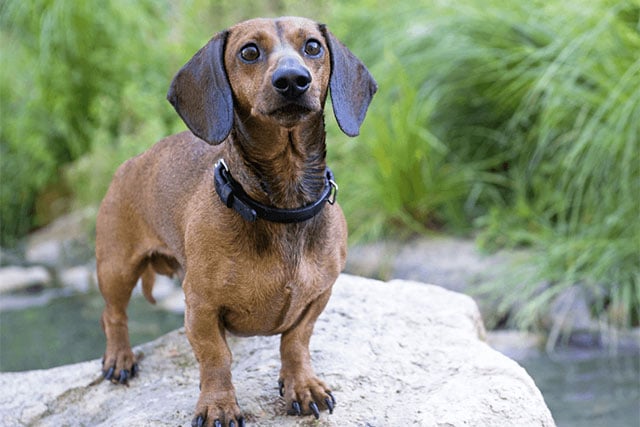
What Diet & Supplements Does Your Dachshund Need?
Proper diet is an essential part of dachshund care routine. The reason why dachshund eats isn’t survival but thriving; their meals have to be in a synchronised and ordered fashion, containing all they require to grow, be happy, be active and live longer.
The morphological structure of an average ‘Wiener Dog’ i.e. a dachshund and their playfulness, agility, and hyper-activeness make top priorities in its required feeding and diet.
Their elongated bodies, short legs, and their entire body build make them susceptible to a few health issues, and one of the ways to tackle this issues is creating a healthy and balanced diet plan for them.
Dachshund diet basics
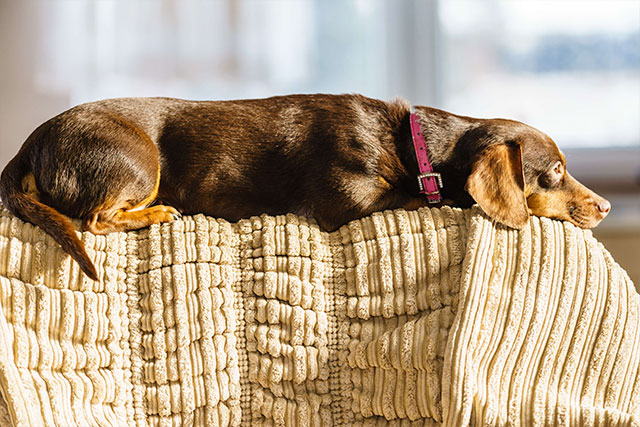
With all the energy sausage dogs pool together to play, get by and keep alive on a daily basis, they need a good portion of dog food.
Science has proven and informed us that the average puppy needs approximately 600 calories daily while the more energetic one can have up to 900 calories, but old or less active dachshunds calorie intake should be reduced to 470 calories.
Since there are the regular sized wiener dogs and the miniature ones; there are a few discrepancies in their food intake.
The smaller dachshunds need just about 240 calories and may need to eat up to 4 times daily while the regular adult sausage dog can be fed up to 350 calories.
Dachshund puppy’s diet basics
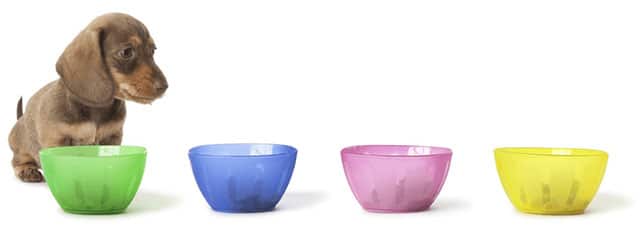
When switching for dry food, carefully monitor any food allergy signs
The difference in the calories intake for younger dogs and older dogs is because of the required energy needed for proper bone development and growth in the young pups.
Dachshund puppies – less than three months old should be fed moist food but once they celebrate their third month birthday, wean them off that and make a switch to dry foods.
When switching to dry foods, carefully monitor the food allergy signs such as itching, swelling or dry coat.
Water intake
Don’t forget that water is a very vital part of your dog’s diet. Humans are said to be made up of 75% water and dachshund’s entire body is made up of 65%.
Your dachshund should have water readily available as he wouldn’t come running to you yelling “Mama, may I have some water.”
Allergens
Did you know that common dachshund allergens are grains, as well as chocolate and grapes? Be on the lookout for some signs when he eats a grain-based food.
If you want to find out more about allergens and toxins, affecting dachshunds, you will find more detailed information in the article Dachshund lifespan.
Make sure that the kibble you give to your sausage dog has infused with a high-quality protein such as meat meals.
According to the RDA (Required Daily Allowance), a dachshund needs a total of 22 different kinds of proteins. Overall. When coming to a conclusion of choosing food for your cute pet, consider their weight, level of activity and age.
The entire diet of this dog should contain adequate protein, fat, carbohydrates, vitamins and minerals in their proper proportion and all these collectively lead to the raising of a healthy dachshund.
Dachshund supplements
Let’s talk about supplements, shall we?

Some people give their dachshunds joint supplements like Glucosamine hoping they will avert or reduce the risk of joint, back and spinal problems. Other popular supplements include fish oil, probiotics and multivitamins.
Why not try to supplement your dachshund’s morning meals with Cod-liver oil?
It will provide your dog with essential Omega 3 fatty acids and is a great supply of vitamins A, D and E. It is a great way to improve the condition of your dachie’s coat, teeth and skin.
Before making a supplement decision, consider those that will support strained activities such as taking long walks.
Dachshund Care: Weight Management
The body of an average dachshund should be muscular, with their chest bone protruding like a soldier with his chest out taking a salute.
If there’s fat around its chest or around waistline that seems like a mismatch to the rest of the frontal body, your cutie might be overweight.
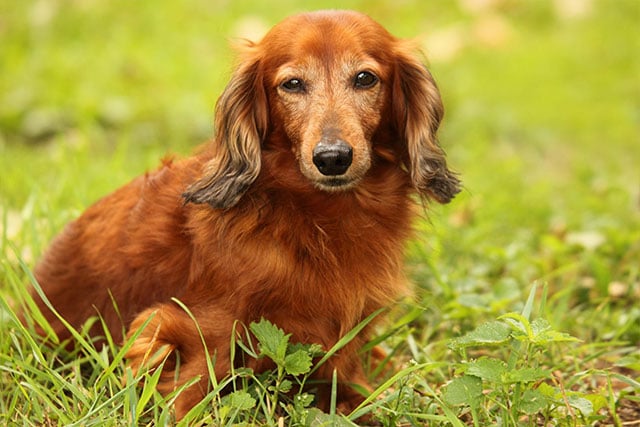
What’s the next step of action when you find out your dachshund is overweight? The same thing you do when you have an overweight kid: reduce calorie intake.
Before you embark on this new journey, our best advice is you consult a veterinarian on the perfect approach and procedure to help your sausage dog back in its hot shape.
What about random weight loss? Still, consult this expert, it could be an internal factor such as the presence of intestinal parasites in its GIT.
How do you deal with an obese dachshund? This breed is very prone to diabetes which will eventually result in diabetes.
The simplest way to reduce this vulnerability is to avoid giving them human food. Love them with everything you can except with your meal.
Dachshund Care: Grooming
This is one of our favorite dachshund care step. Sausage dogs are pretty; they come in two sizes – miniature and standard but in three coat types: wirehaired, long-haired and smooth.
The smooth haired dachshunds do not require much pretty boy swag; they do not have the usual weird doggy smell and might not need to bathe often unless they fall into a pool of filth, real-time filth.
If you notice a dirty part of his body, a good baby wipe or damp clothes will keep him looking like some good and expensive than leather oxford classic shoes.
Long Haired dachshunds require regular (almost as breathing) bathing majorly because of their hair and after bathing, they need to be blow-dried. These are the ones you get to stroke while brushing their hair.
The processes involved in the grooming a longhaired dachshund include: bathing, brushing and trimming. The earlier you get your sausage dog accustomed to grooming, the easier it becomes.
Start on them when they are pups – bathe, brush and trim them to avoid tangles and external objects clogging up the hair and as they grow, they’d get used to it.
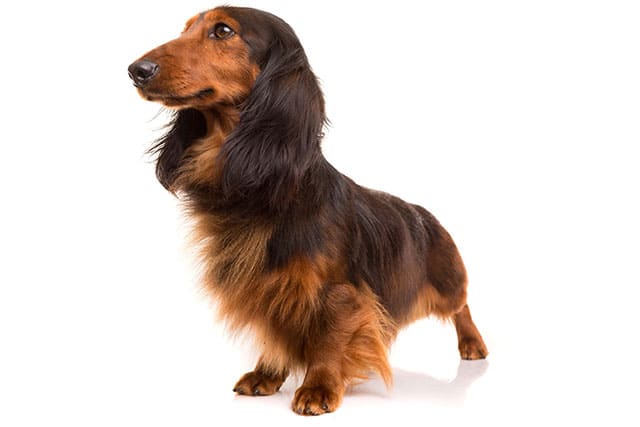
One of the items you should consider investing in is a DOG GROOMING TABLE, seeing as the long-haired dachshunds require regular grooming.
They are widely available in the stores now, and some come with a rotating top so you can turn your sausage dog around to different sides for grooming. Others come with a protective clip to help your dog stay still while you doll him up.
If you want to find out more about dachshund grooming, we wrote a separate detailed article that you can find here.
Dachshund Care: Exercise & Activity Requirements
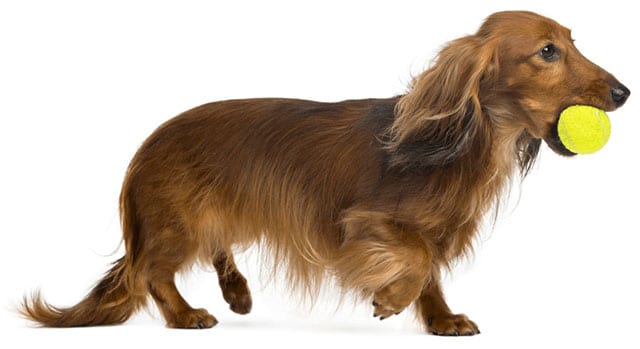
Just as humans have to get their heart pumping, their muscles moving and their joints working, so does dachshunds need to exercise.
Their origin shows that these specific dogs were trained to hunt, for badgers( some millennials probably don’t know what animal this is) and so their body evolved into that job description, and that evolution can be seen in the typical appearance of all kinds of dachshunds.
Sausage dogs were working dogs; running, racing, burrowing and sniffing all over the field and now they belong to you, and you have full- house dog ambitions for them!
Don’t get me wrong, dachshunds make terrific house pets, but they need to keep grinding, sweating and lifting (maybe this lifting part is an exaggeration)
Their high level of energy makes them require more than a stroll in the park or a regular walk with the dog walker. Your sausage dog needs a routine of daily exercise to be and remain healthy and happy; or else it will become a whining, attention-seeking and cranky little adorable dog.
Plan a routine that will test dachshund’s muscle, stamina, and brains. These daily routines will help reduce the risk of the problems their kinds are prone to, will result in an emotionally independent dog and a cooperative one.
I can’t remember where specifically, but some time ago, I read that exercises help build their confidence, trust and improve their digestion.
Remember, don’t form the habit of allowing your sausage dog run and down the stairs all the name of playing games or working out; that kind of exercise is dangerous for their backs.
The best way to help your dachshund live longer?
Watch our video to find out!
These three exercises and activities should be considered for your sausage dog:
Walking with your dachshund
What dog doesn’t love nature? It doesn’t matter how fancy their little kennels or sleep pouches are; they are always excited to go out, smell the air, bask in the sun and just enjoy the atmosphere.
Once dachshunds get fully grown, they must have built a lot of strength, and they’d love to run, but they often take short breaks in between those races.
The walking is essential to dachshunds, it keeps their brain active, but most importantly, the walks are also good for their emotional wellbeing.
Dachshunds are very social dogs, and you must have noticed it in the way they seem to explore new stuff and smell people that come around.
So, when you take your sausage dog on a walk, let him explore with his sense of smell, help him socialise with other people and dogs.
Just make your dachshund feel like a part of a happy community. These walks have to be consistent and super fun, and once you get home, your doxie will most likely retire to his favourite corner, curl up and sleep.
Agility game with your dachshund
When it comes to games, the wiener dogs are always ready as well. You can start with the agility game where you engage their natural hunting instincts.
To initiate this game, pick the object you prefer, maybe a shoe, a plate or a ball and show the object to your sausage dog.
Ensure to say the name of the object to your dachshund, he might not say it back (or bark back), but he has taken a mental note. Then let him smell it; let him take in the scent of the object.
Go and hide the object. When you’ve hidden it, tell your sausage dog to find it, and you’ll see him sniffing everywhere he gets to looking to recognise the scent he already memorised.
Fetch game with your dachshund
Another activity your sausage dog can be involved in is the regular Fetch game almost every kind of dog play but remember to take breaks in between for dachshunds.
Dachshund Care: Medical Visits And Vaccinations

If you don’t want a rough year, you should take your dachshund to visit the veterinarian. The frequency of your visit depends on the age, health status and physical issues of your sausage dog.
There are no one-size fits all approach to this, but older dachshunds should visit the vet more often because their increase in age leads to a decrease in immunity and they are very prone to illnesses and diseases.
A regular checkup is required at various intervals so the overall wellbeing can be assessed, from weight to dental check-up.
The doxies are prone to viral and bacterial infections, but most of the dog kinds of these infections can be prevented by vaccinations ( especially infections like rabies, parvo, and distemper).
Insurance For Your Dachshund
You need the right level of information to pick the right insurance policy for your sausage dog.
The best choice of having careful thought of the pros and cons of the different kinds of insurance for your dachshund is the lifetime policy.
Truly, this plan is more expensive than most basic policies, but the benefits can’t be understated. Firstly, the financial investment every time a relapse happens is capped; especially for degenerative and recurring kinds.
Trainability
Teach your dachshund to heel, sit and obey whatever instruction you voice out. Teaching him to heel is very important because of his hyper-activeness and high energy drive; he’d want to walk ahead of you most times.
Teaching him to put a leash on him to learn how to walk with you side-by-side. Teaching him to sit requires much attention because sitting is good for his back.
Once you’ve observed that your sausage dog has been active and playful, help him learn how to tap out by sitting. Utilise their independence gene and smartness to get them trained early on, and they’d stick to the code.
Training a dachshund requires some strong motivation and fortitude.
Dachshund Care: Dental Hygiene
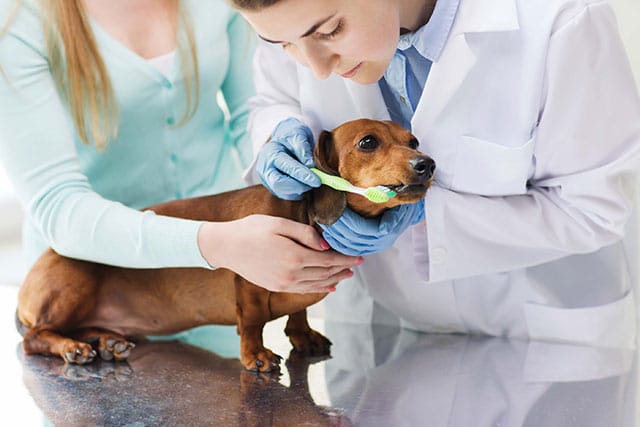
This aspect requires rapt attention. The dog meals available these days are mushy, moist and have different smells, unlike the traditional dog whose primary meal used to be just bones.
For puppies, catch them young. Open their mouths often to rub their gums, more like a gentle massage down the roots. Then run a soft dog toothbrush across its both cheeks and gently on the spiky canines.
As dachshund grows, switch things up to a big animal toothbrush and avoid the use of human toothpaste. Don’t do it. For more information, read our article about how to brush a dog’s teeth.
Try dry foods for your sausage dog to help maintain a good and healthy dental hygiene.
Don’t self medicate when your sausage dog is concerned, if you have a mouth or dental concern, go see a vet. Visit the vet, let him examine your dachshund, and he’ll discuss the diagnosis and choices of available treatment.
Dachshund Emergency Care & First Aid
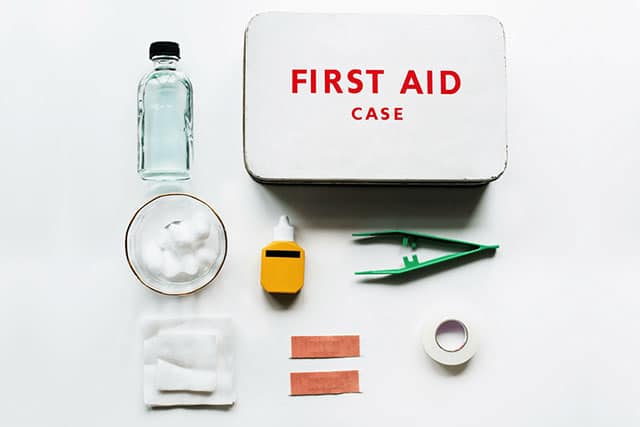
Unforeseen circumstances are the reasons why some dog owners may seem paranoid. They tend to put every check in place, made the house dog-friendly, provide the best food and health experiences yet something might just happen one day to disrupt their perfect process.
Even with our kids, emergencies occur that require you to do the first aid before rushing down to the hospital sometimes.
The same goes for dogs; he might choke on something he was trying to play with but didn’t mean to swallow. I remember watching this documentary on National Geographic about a dog that swallowed a long rod. The owners didn’t even know the rod was missing until they realised he couldn’t move, play or eat.
Then they saw the signs and drove him to this pet specialist who called other colleagues to help her out and eventually after so much precision, carefulness, the rod was pulled out of his mouth. To take care of many emergencies, one should have a proper first aid kit.
First Aid Techniques
How do you measure your dachshund’s heart rate to make sure he is fine when something happens?
It’s almost the same way you measure a human’s. Place your hand on the left side of his chest just below his elbow to feel the beat. Pay attention to count the number of beats in 14 seconds; then multiply it by 4, and this will give you his heart rate. We’ll suggest that the femoral artery is the best place to get a heartbeat from during cases of emergencies.
What about his respiratory rate? Count the breaths he takes in 15 seconds and multiplies by 4.
What if your sausage dog is in shock? Well, how do you know it’s a shock? If your dachshund fell hard or was involved in an accident, the first thing to look out for is bleeding or shock symptoms.
If he isn’t bleeding but he’s in shock, he could be experiencing internal bleeding. If your dachshund in shock, he’ll completely lie on the floor, breathe shallowly and have cold eyes. The best thing to do is wrap him up in a warm blanket and rush to the vet.
First Aid Kit
A complete first aid box for your dog should contain the following:
- Muzzle: this will hold him down when he’s in pain so he doesn’t unleash or bite anyone trying to care for him
- Latex gloves: This is for your own and the dog’s protection; it will prevent the exchange of bacteria
- Bandaging materials such as gauze squares and rolls, bandaging tape, elastic bandage, and scissors
- Electric clippers also; to shave off the hair around an injured part to have access to the sport to clean up
- Rectal thermometer: Get adequate knowledge and information about using this from the vet
- Antiseptic Wash
- Tweezers: to remove glass pieces or splinters from off his body
- Clean towels and blanket
- Antibiotic ointment
- Syringes; without the needles for oral dosage
How Do You Care For A Pregnant Dachshund?
This cuteness overload obeys the laws of natural procreation – they get pregnant after mating and carry their pups for up to 63-65 days, and this time, their bodies experience different stages of changes just like an expecting mother basking in the euphoria of her pregnancy.
In this stage, your dachshund needs your emotional and physical support as this will ensure she gets healthy babies.
How do you figure out your sausage dog is pregnant? She wouldn’t glow or miss her period, so you’ve got to visit the veterinarian, but the first sign is enlarged nipples, yes, the dogs get that too!
After the vet confirms the pregnancy by either running a test or feeling her belly, note the date so you can approximate the due date of the conception and know how to track the milestones of the gestation period.
Caring about pregnant dachshund
Once your dachshund is in her sixth week, increase her intake of high-quality foods, and you could maybe try out the usual practice – some people give their pregnant dachshund puppy food because of its high vitamin and mineral content.
These pregnant dogs are really eating for two; feed more food than they would typically indulge in – this will ensure that the newbies are getting all the food and nutrient they need.
The next habit to keep maintaining is the activity and exercising; keep them strolling and walking to help their babies positioning and avoidance of back problems. In this gestation period, avoid vaccination, have a conversation with your vet about the usual vaccine prescription before and for the pregnancy.
Isolate your sausage dog from other pet as soon as it’s three weeks to her due date so they wouldn’t pull her into their energetic run or pass diseases to her.
The next thing is to look out for WHELPING signs; the temperature usually increases when it’s time to bring the pups out.
Caring about new born dachshund puppies
Now that the newborn puppies are here, what next?
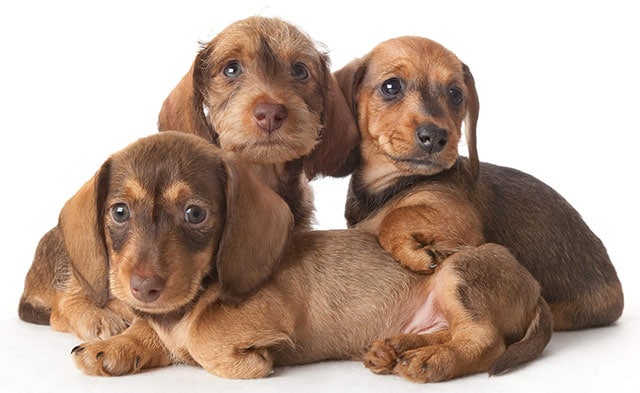
Make sure the new puppies are dried as the coldness or chill can be life-threatening. Once this is settled, encourage the mother to feed their puppies as soon as everyone is cleaned up.
But what if the puppies don’t feed or mom wouldn’t allow them to feed directly from the nipples? Get them puppy milk prepared from powder in bottles every two hours.
You need to switch up the mother dachsie’s diet with one rich in protein and calcium especially if she’s nursing. The calcium will replenish and restore her body’ stores, and she will help transfer protein via her milk to the newborns.
You need to weigh each puppy using appropriate scales, and this should be done regularly. Remember that if there’s drastic weight gain or loss, seek medical help.

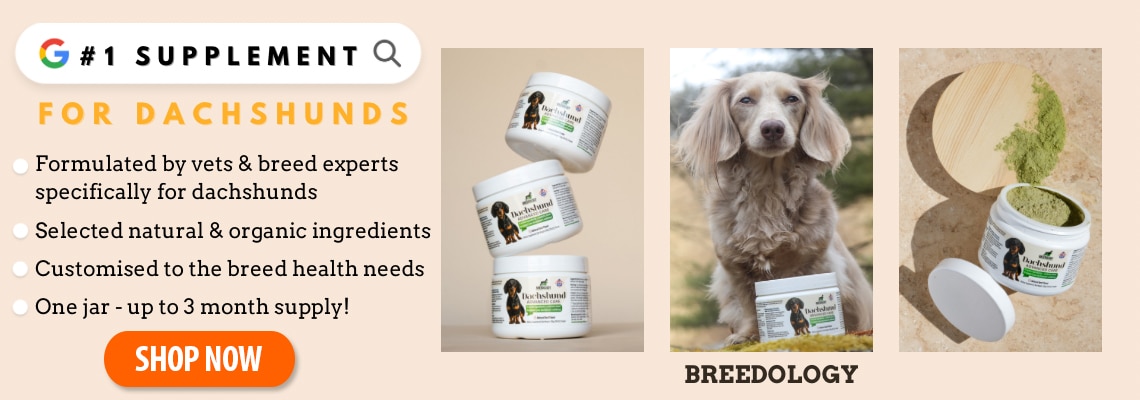
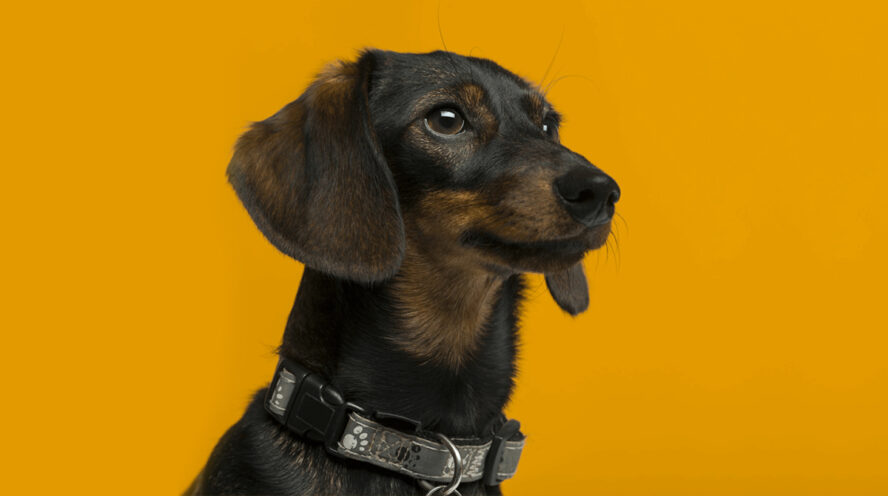
Comments
Best food for over weight pup? (14 year old) And how much?